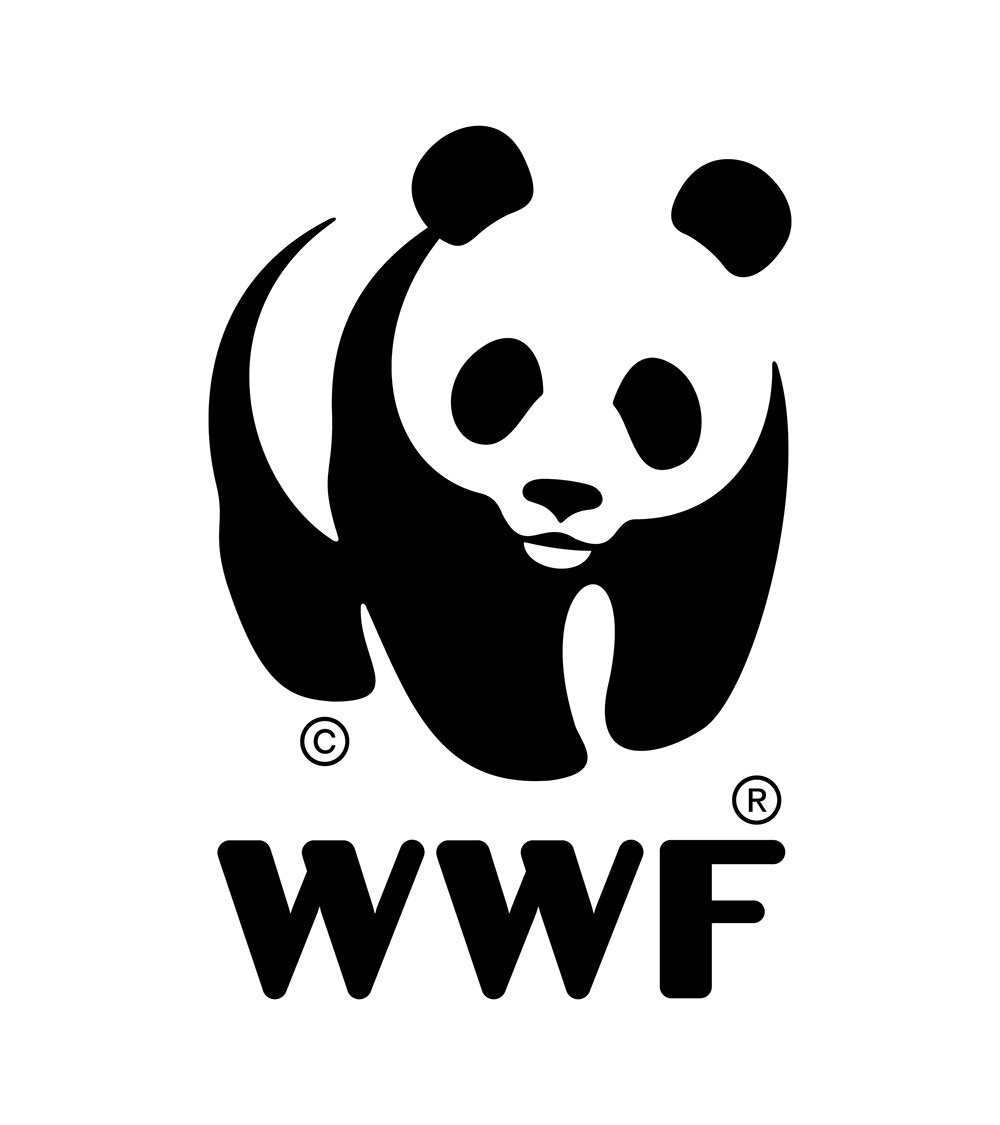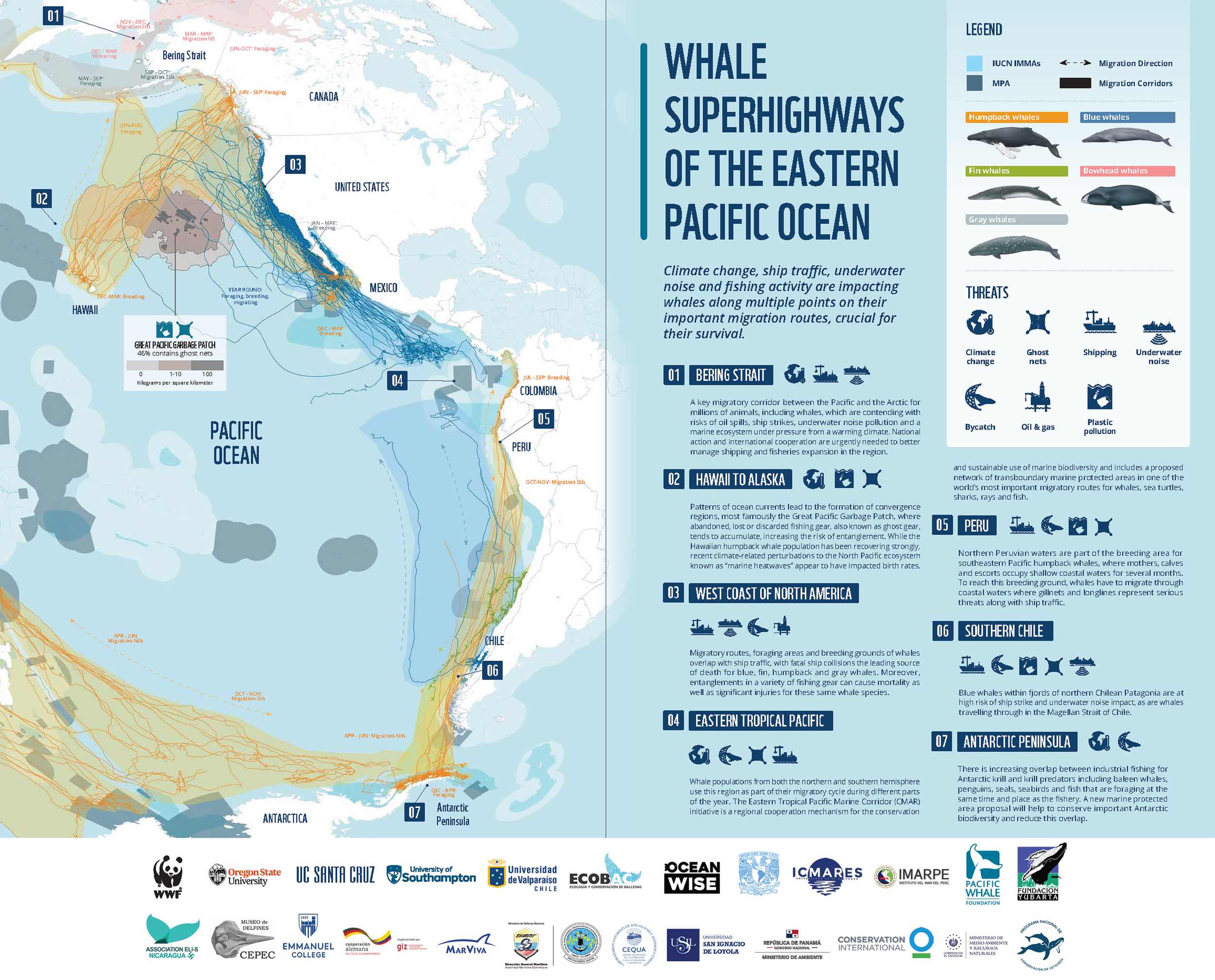Eastern Pacific Ocean - A hub for whale superhighways requires urgent protection
A new report by WWF and the marine mammal science community, calls for urgent cooperation to safeguard migrating whale populations, mitigate threats, and take action across the region.
A new report from WWF and partners, including Oregon State University, the University of California Santa Cruz, the University of Southampton, and Universidad de Valparaiso, identifies actions for governments, industry and individuals to safeguard whale migratory routes, along the Eastern Pacific Ocean by 2030. Climate change, ship traffic, underwater noise and fishing activity impact whales and their survival at multiple points.
Released today, Blue Corridors of the Eastern Pacific Ocean, Opportunities and Actions to Protect Migratory Whales, includes a visualization highlighting routes that stretch along the Eastern Pacific Ocean from pole to pole. These migratory routes or blue corridors are like whale superhighways, covering significant distances from the Bering Strait, south to the temperate and tropical Pacific, all the way down to the Antarctic Peninsula, sometimes spanning thousands of kilometers. Twelve out of fourteen species of great whales use the Eastern Pacific Ocean as a migratory hub.
During the 20th century, nearly 3 million whales were commercially harvested, driving many species to the brink of extinction. [1] Today, there is significantly less commercial whaling allowing some populations to thrive. But new threats are emerging [2, 3] making the migratory routes of these whales increasingly dangerous to navigate.
“Whales rely on important ocean areas to feed, mate, give birth, nurse young, socialise and migrate. These areas are being impacted by multiple human activities and are under increasing stress,” said Chris Johnson, Global Lead for whale and dolphin conservation at WWF. “We have the knowledge and the strategies to better conserve and protect these areas. We call for urgent cooperation to safeguard whales throughout their entire oceanic range.”
As the threats to whales evolve, our conservation approach must also evolve. The report identifies actions for governments, industry and individuals to safeguard whale superhighways across the Eastern Pacific Ocean by 2030. Networks of Marine Protected Areas, or MPAs, cross national jurisdictions to create interconnected networks to protect wildlife and the ecosystems they rely on to survive.
WWF calls for governments to support the Americas Protection of the Oceans joint declaration to implement networks of MPAs and OECMs, Other Effective Area-Based Conservation Measures, in the Eastern Pacific Ocean, with the goal of protecting or conserving at least 30 per cent of the ocean by 2030.
“The successful implementation and design of MPAs and OECMs is not possible without the equitable participation of Indigenous Peoples, local communities, local, regional and national governments,” said Yacquie Montecinos, Marine Biodiversity and Ocean Policy Coordinator at WWF-Chile. “Healthy oceans and the marine species living in them provide natural solutions to climate adaptation and resilience. Evidence shows whales play a critical role in maintaining ocean health and our global climate. We must work harder to protect our ocean for nature and people.”
The report also outlines other actions, including working to achieve zero whale entanglements by fisheries, reducing plastic and other pollution, and re-routing shipping lanes away from critical whale habitats, such as seasonal migration areas. Supporting actions like the UN Plastics Treaty and the Ghost Gear Initiative are just some ways to make a difference for whales.
Visualizing these migratory routes provides a concrete guide to help empower and inform conservation actions to protect migratory whales in the Eastern Pacific Ocean. The scientific data used to build this map is a collaborative effort by more than 50 research groups, with leading marine scientists from Oregon State University, the University of California Santa Cruz, the University of Southampton, Universidad de Valparaiso and others.
“This ground-breaking research presents so many innovative approaches to help protect whales. Safeguarding the blue corridors of the Eastern Pacific Ocean requires a holistic strategy, one that engages multiple international and regional organizations responsible for forming policies across a range of areas and industries, from fisheries to shipping, including key organisations such as the International Whaling Commission (IWC), the International Maritime Organization (IMO), and the Permanent Commission of the South Pacific (CPPS) to name a few,” said Dr. Daniel M. Palacios of the Marine Mammal Institute, Oregon State University. “Compiling the whale satellite tracking data as the starting point has galvanized regional researchers, WWF, and partners to take things to the next level by integrating it with information on threats in order to propose effective policy solutions.”
Implementing networks of MPAs is a proven conservation tool designed to protect biodiversity, promote healthy and resilient marine ecosystems, and provide societal benefits. [4] Yet, today, only 8.16 per cent of the world’s oceans have actively managed MPAs.
“Growing evidence shows, our oceans need thriving whale populations to enhance marine productivity and play a role in carbon capture,” said Chris Johnson. “Backed by solid science, they are also revealing to us how we can connect networks of protected areas to achieve 30x30.”
Whales have intrinsic value, and our oceans need thriving populations. The benefits they provide – from capturing carbon to enhancing marine productivity – only strengthen the case for protecting them. [5, 6]
Blue Corridors of the Eastern Pacific Ocean, Opportunities and Actions to Protect Migratory Whales is launching at the Our Ocean Conference. The full report is available for download.
Notes to Editor
More images are available.
For more information, lead authors are available for interviews:
Fanni Barocsi, Protecting Whales & Dolphins Initiative Communications Lead - fbarocsi@wwf.org.au
Contributors of satellite tag data of whales featured in the report
Ari Friedlaender (UCSC), Daniel Palacios (Oregon State Univ.), Ryan Reisinger (Univ. of Southampton), Andy Willson (Future Seas), Alex Zerbini (CICOES-UW, NOAA, Marecotel & Instituto Aqualie), O. Adam (Neurosciences Paris Saclay), Alejandro Fernandez Ajó (Northern Arizona University), Artur Andriolo (UFJF, Instituto Aqualie), Virginia Andrews-Goff (Australian Antarctic Division), Salvatore Cerchio (African Aquatic Conservation Fund), Phillip Clapham (Seastar Scientific), Rochelle Constantine (University of Auckland), Mariano Coscarella (CESIMAR-CENPAT), Enrique Crespo (CESIMAR-CENPAT), Environment Society of Oman, Tim Collins (Wildlife Conservation Society), Luciano Dalla Rosa (Universidade Federal do Rio Grande), Mike Double (Australian Antarctic Division), Violaine Dulau (Globice), Matias Di Martino, Ken Findlay (Cape Peninsula University of Technology), Santiago Fernandez (CESIMAR-CENPAT), Raul González (CIMAS / EsCiMar), Claire Garrigue (UMR ENTROPIE), Guillermo Harris (Wildlife Conservation Society), Jason How (Department of Primary Industries and Regional Development), F. Mayer (Cetamada NGO), Curt and Micheline-Nicole Jenner (Centre for Whale Research), Christian Lydersen (Norwegian Polar Institute), Carina Marón (Wildlife Conservation Society), Bruce Mate (Oregon State University), Martin Mendez (WCS), Simone Panigada (Tethys Research Institute), Howard Rosenbaum (WCS), Rui Prieto (University of the Azores), Mduduzi Seakamela (Department of Environmental Affairs), Maritza Sepulveda (Universidad de Valparaiso), Monica Silva (University of the Azores), Roxana Schteinbarg (ICB Argentina), Mariano Sironi (ICB Argentina), Diego Taboada (ICB Argentina), Raquel Soley (ICB Argentina), Nicolás Lewin (ICB Argentina), Marcos Ricciardi (ICB Argentina), Federico Sucunza (Instituto Aqualie), Laurène Trudelle (Neurosciences Paris Saclay), Matthew Witt (University of Exeter), Judy Uhart, Marcela Uhart (UC Davis), Florencia Vilches and Victoria Zavattieri (Wildlife Conservation Society).
Sources
Rocha, R. C., Jr, Clapham, P. J., Ivashchenko, Y., Rocha, R. C., Clapham, P. J., Ivashchenko, Y., Rocha, R. C., Jr, Clapham, P. J. & Ivashchenko, Y. Emptying the Oceans: A Summary of Industrial Whaling Catches in the 20th Century. Mar. Fish. Rev. 76, 37–48 (2014).
Avila, I. C., Kaschner, K. & Dormann, C. F. Current global risks to marine mammals: Taking stock of the threats. Biol. Conserv. 221, 44–58 (2018).
Nelms, S. E., Alfaro-Shigueto, J., Arnould, J. P. Y., Avila, I. C., Bengtson Nash, S., Campbell, E., Carter, M. I. D., Collins, T., Currey, R. J. C., Domit, C., Franco-Trecu, V., Fuentes, M., Gilman, E., Harcourt, R. G., Hines, E. M., Rus Hoelzel, A., Hooker, S. K., Johnston, D. W., Kelkar, N., Kiszka, J. J., Laidre, K. L., Mangel, J. C., Marsh, H., Maxwell, S. M., Onoufriou, A. B., Palacios, D. M., Pierce, G. J., Ponnampalam, L. S., Porter, L. J., Russell, D. J. F., Stockin, K. A., Sutaria, D., Wambiji, N., Weir, C. R., Wilson, B. & Godley, B. J. Marine mammal conservation: over the horizon. Endanger. Species Res. 44, 291–325 (2021).
Grorud-Colvert, K., Sullivan-Stack, J., Roberts, C., Constant, V., Horta E Costa, B., Pike, E. P., Kingston, N., Laffoley, D., Sala, E., Claudet, J., Friedlander, A. M., Gill, D. A., Lester, S. E., Day, J. C., Gonçalves, E. J., Ahmadia, G. N., Rand, M., Villagomez, A., Ban, N. C., Gurney, G. G., Spalding, A. K., Bennett, N. J., Briggs, J., Morgan, L. E., Moffitt, R., Deguignet, M., Pikitch, E. K., Darling, E. S., Jessen, S., Hameed, S. O., Di Carlo, G., Guidetti, P., Harris, J. M., Torre, J., Kizilkaya, Z., Agardy, T., Cury, P., Shah, N. J., Sack, K., Cao, L., Fernandez, M. & Lubchenco, J. The MPA Guide: A framework to achieve global goals for the ocean. Science 373, eabf0861 (2021).
Savoca, M. S., Czapanskiy, M. F., Kahane-Rapport, S. R., Gough, W. T., Fahlbusch, J. A., Bierlich, K. C., Segre, P. S., Di Clemente, J., Penry, G. S., Wiley, D. N., Calambokidis, J., Nowacek, D. P., Johnston, D. W., Pyenson, N. D., Friedlaender, A. S., Hazen, E. L. & Goldbogen, J. A. Baleen whale prey consumption based on high-resolution foraging measurements. Nature 599, 85–90 (2021).
Pearson, H. C., Savoca, M. S., Costa, D. P., Lomas, M. W., Molina, R., Pershing, A. J., Smith, C. R., Villaseñor-Derbez, J. C., Wing, S. R. & Roman, J. Whales in the carbon cycle: can recovery remove carbon dioxide? Trends Ecol. Evol. (2022) doi:10.1016/j.tree.2022.10.012


